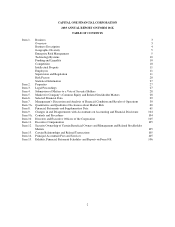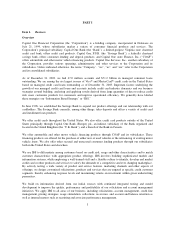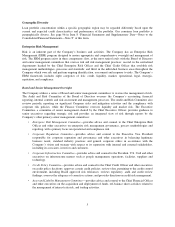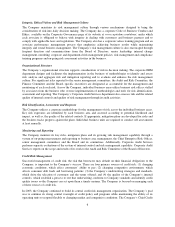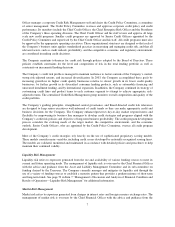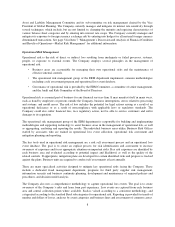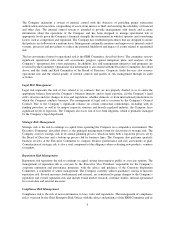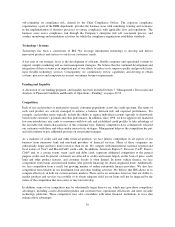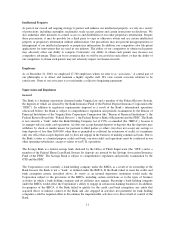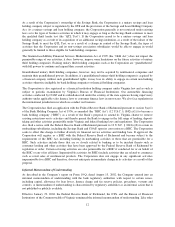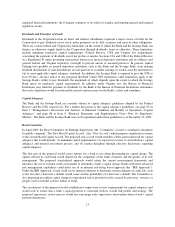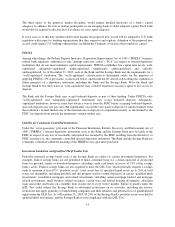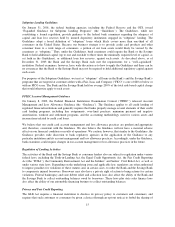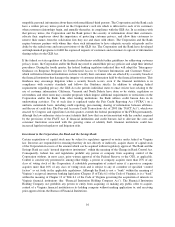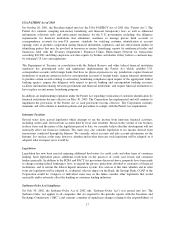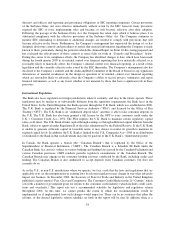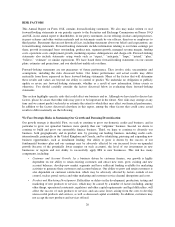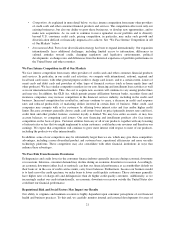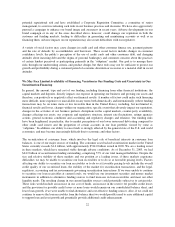Capital One 2003 Annual Report Download - page 30
Download and view the complete annual report
Please find page 30 of the 2003 Capital One annual report below. You can navigate through the pages in the report by either clicking on the pages listed below, or by using the keyword search tool below to find specific information within the annual report.As a result of the Corporation’s ownership of the Savings Bank, the Corporation is a unitary savings and loan
holding company subject to regulation by the OTS and the provisions of the Savings and Loan Holding Company
Act. As a unitary savings and loan holding company, the Corporation generally is not restricted under existing
laws as to the types of business activities in which it may engage so long as the Savings Bank continues to meet
the qualified thrift lender test (the “QTL Test”). If the Corporation ceased to be a unitary savings and loan
holding company as a result of its acquisition of an additional savings institution, as a result of the failure of the
Savings Bank to meet the QTL Test, or as a result of a change in control of the Savings Bank, the types of
activities that the Corporation and its non-savings association subsidiaries would be able to engage in would
generally be limited to those eligible for bank holding companies.
The Gramm-Leach-Bliley Financial Services Modernization Act of 1999 (the “GLB Act”) does not impact the
permissible range of our activities; it does, however, impose some limitations on the future activities of unitary
thrift holding companies. Existing unitary thrift holding companies such as the Corporation are “grandfathered”
with full powers to continue and expand their current activities.
Grandfathered unitary thrift holding companies, however, may not be acquired by nonfinancial companies and
maintain their grandfathered powers. In addition, if a grandfathered unitary thrift holding company is acquired by
a financial company without such grandfathered rights, it may lose its ability to engage in certain non-banking
activities otherwise ineligible for bank holding companies or financial holding companies.
The Corporation is also registered as a financial institution holding company under Virginia law and as such is
subject to periodic examination by Virginia’s Bureau of Financial Institutions. Our automobile financing
activities conducted by COAF and its subsidiaries fall under the scrutiny of the state agencies having supervisory
authority under applicable sales finance laws or consumer finance laws in most states. We also face regulation in
the international jurisdictions in which we conduct our business.
The Corporation has filed an application with the Federal Reserve Bank of Richmond pursuant to section 3(a)(1)
of the Bank Holding Company Act of 1956, as amended (the “BHC Act”) (12 U.S.C. § 1842(a)(1)) to become a
bank holding company (“BHC”) as a result of the Bank’s proposal to amend its Virginia charter to remove
existing restrictions on its activities and thereby permit the Bank to engage in the full range of lending, deposit-
taking and other activities permissible under Virginia and federal banking laws and regulations. The Corporation
also filed a notice with the Federal Reserve Bank of Richmond pursuant to 12 U.S.C. § 1843(c)(8) to retain its
nonbanking subsidiaries, including the Savings Bank and COAF, upon its conversion to a BHC. The Corporation
seeks to effect this change to further diversify its financial service activities and funding base. If approved, the
Corporation will register as a BHC with the Federal Reserve Bank of Richmond and become subject to the
requirements of the BHC Act, including limiting its nonbanking activities to those that are permissible for a
BHC. Such activities include those that are so closely related to banking as to be incident thereto such as
consumer lending and other activities that have been approved by the Federal Reserve Bank of Richmond by
regulation or order. Certain servicing activities are also permissible for a BHC if conducted for or on behalf of
the BHC or any of its affiliates. Impermissible activities for BHCs include activities that are related to commerce
such as retail sales of nonfinancial products. The Corporation does not engage in any significant activities
impermissible for a BHC and therefore, does not anticipate an immediate change in its activities as a result of this
proposal.
Informal Memorandum of Understanding
As described in the Company’s report on Form 10-Q, dated August 13, 2002, the Company entered into an
informal memorandum of understanding with the bank regulatory authorities with respect to certain issues,
including capital, allowance for loan losses, finance charge and fee reserve policies, procedures, systems and
controls. A memorandum of understanding is characterized by regulatory authorities as an informal action that is
not published or publicly available.
Effective January 29, 2004, the Federal Reserve Bank of Richmond, the OTS, and the Bureau of Financial
Institutions of the Commonwealth of Virginia terminated the informal memorandum of understanding. Like other
12


